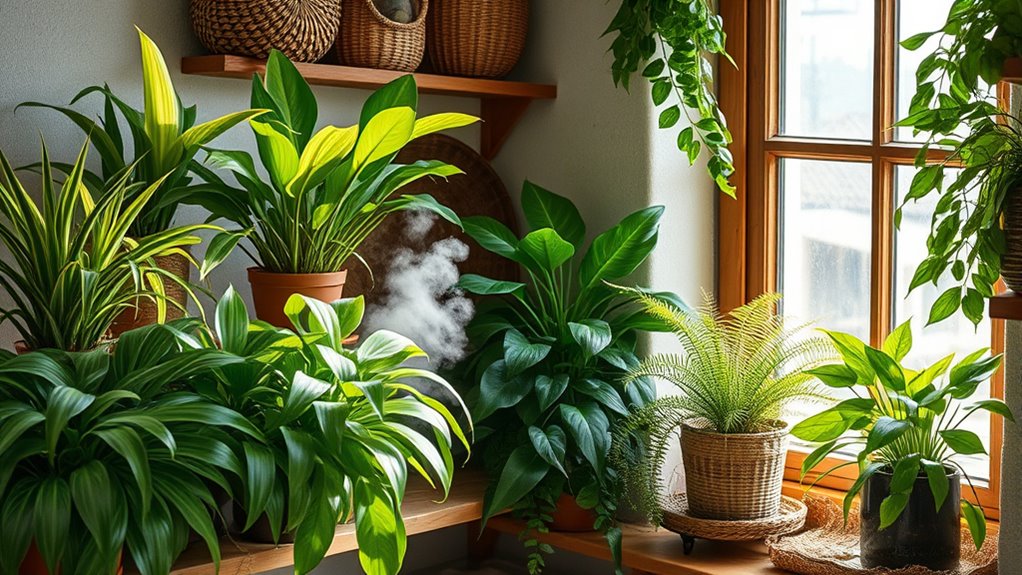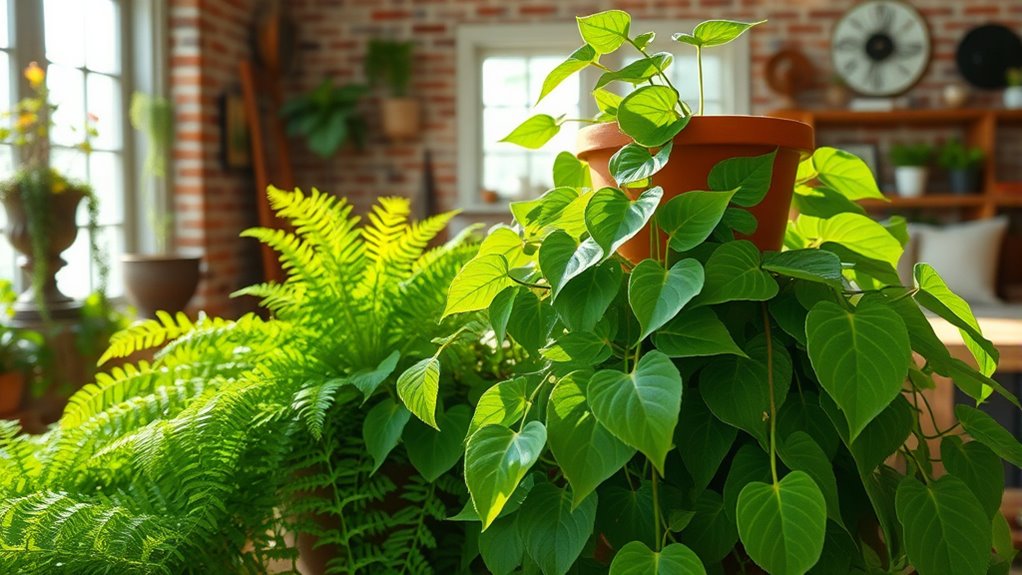Indoor plants do more than just add beauty; they actively improve rural air quality by filtering out pollutants like formaldehyde and benzene, which often come from household products and outdoor sources. Regular maintenance, watering, and pest control are key to keeping them healthy and effective. Healthy plants can help reduce dust, allergens, and even harmful toxins, creating fresher, cleaner indoor air. If you want to discover more hidden benefits, keep exploring how these green companions can enhance your environment.
Key Takeaways
- Indoor plants filter out rural indoor pollutants like dust, pesticides, and outdoor toxins, improving air quality.
- They increase oxygen levels, supporting healthier breathing especially in rural areas with higher particulate matter.
- Proper plant maintenance prevents pests that can introduce allergens or mold, safeguarding air quality.
- Plants help reduce dust accumulation indoors, contributing to cleaner air in rural homes.
- By absorbing airborne toxins, indoor plants create a safer, fresher environment for rural inhabitants.

Indoor plants can considerably improve rural air quality by naturally filtering out pollutants and boosting oxygen levels. When you bring plants into your space, you’re not only enhancing the aesthetic but also creating a healthier environment. These plants absorb airborne toxins like formaldehyde, benzene, and trichloroethylene, which can come from household products, dust, or outdoor pollution seeping indoors. As a result, the air you breathe becomes cleaner and fresher, making your living space more comfortable and inviting.
Maintaining your indoor plants is essential for these benefits to last. Regular plant maintenance involves watering appropriately, ensuring proper lighting, and pruning dead or yellowing leaves. When you stay attentive to your plants’ needs, they stay healthy and continue to purify the air effectively. Proper plant maintenance also reduces the risk of pest infestations, which can compromise your plants’ health and your indoor air quality. Pests like spider mites, aphids, or fungus gnats tend to thrive in unkempt plants, and their presence can introduce allergens or mold into your environment. To prevent this, inspect your plants regularly, keep the soil surface dry, and clean the leaves gently with a damp cloth. If pests appear, act quickly with natural remedies or insecticidal soap to prevent an infestation from spreading. Additionally, healthy plants are better at fetal development, as they contribute to a balanced indoor atmosphere that supports overall well-being.
Frequently Asked Questions
How Do Indoor Plants Improve Rural Air Quality Compared to Outdoor Plants?
Indoor plants improve rural air quality by actively absorbing pollutants through their leaves, helping to reduce airborne contaminants. Compared to outdoor plants, they can be more effective because you can select specific plants known for high pollutant absorption and place them strategically indoors. This targeted plant selection allows you to optimize air purification, especially in areas where outdoor air quality fluctuates or is less controllable, making your indoor environment healthier.
What Are the Best Indoor Plants for Filtering Rural Air Pollutants?
Imagine your home as a breathing oasis—your plant selection becomes the filter for rural air pollutants. Opt for spider plants, snake plants, and peace lilies; they’re like silent guardians, tirelessly working to purify your air. These indoor plants excel at air purification, capturing toxins and releasing revitalizing oxygen. By choosing the right greenery, you transform your space into a sanctuary of cleaner, healthier air, making every breath a invigorating breeze.
Can Indoor Plants Help Reduce Indoor Dust and Allergens in Rural Homes?
Indoor plants can help reduce dust and allergens in your rural home by trapping particles on their leaves and improving overall air quality. To maximize benefits, you should focus on proper plant maintenance, like regular cleaning and watering, which keeps the plants healthy and effective. Healthy plants also promote better soil health, supporting their ability to filter pollutants and allergens, creating a cleaner, healthier living environment for you.
Do Indoor Plants Require Special Care in Rural Environments?
Unlike the days of yore, indoor plants in rural environments don’t demand much special care. You simply need to monitor soil moisture, ensuring it’s not too dry or soggy, and keep pests at bay with natural pest control methods. These plants thrive with basic attention, making them low-maintenance companions that enhance your indoor air quality without fuss, even amidst rural settings.
Are There Any Health Risks Associated With Keeping Indoor Plants in Rural Areas?
You might wonder if indoor plants in rural areas pose health risks, and it’s a valid concern. Some toxic plant species could cause allergic reactions or poisoning if ingested or touched. Additionally, pesticide exposure from nearby agriculture might settle on your plants, risking inhalation or skin contact. To stay safe, choose non-toxic plants and wash them thoroughly, and avoid plants treated with pesticides.
Conclusion
By embracing indoor plants, you subtly nurture a healthier environment within your home, gently enhancing rural air quality without drawing too much attention. These verdant companions quietly work alongside you, fostering a sense of calm and balance. While their presence may seem simple, their quiet contributions weave a delicate tapestry of wellness, reminding you that sometimes, the smallest touches can profoundly influence the harmony of your space. In nurturing plants, you nurture a better tomorrow.











